
Walnut Studiolo offers a clever way to port a 6-pack along for the ride.
You’re reading Signal v. Noise, a publication about the web by Basecamp since 1999. Happy !

Walnut Studiolo offers a clever way to port a 6-pack along for the ride.
“Do you want to sell sugar water for the rest of your life, or do you want to come with me and change the world?”
David Heinemeier Hansson, partner at 37signals and creator of Ruby on Rails, instant messaged me one day in December 2010.
Hey, you want to design graphics for a race car?
Hells yeah. Initially I had a clear vision of how I wanted the design to look. I wanted to create a pixelated affect using the iconic 37signals logo (designed by Ammon Haggerty) across the body of the car. The tricky part was the color scheme. I had really no idea where to start. Here are the various colors I tried:

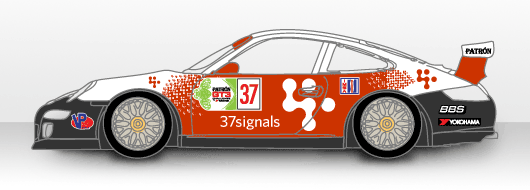
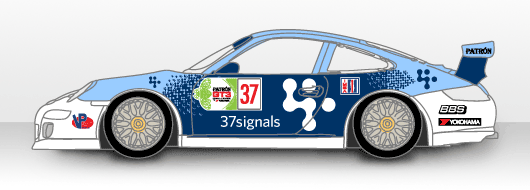
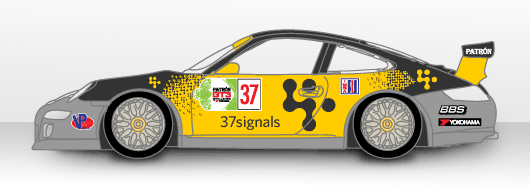
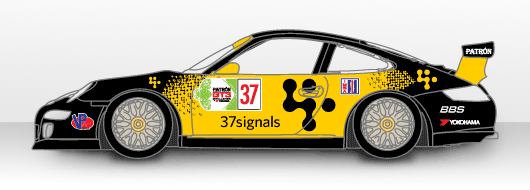
Actually what’s funny is I sprinted on this for 1 week after David approached me with the project. This was right around New Year’s, so I didn’t have a lot going on. After these initial designs I got swept away with other duties (like designing materials for the 37signals Suite). I dropped the ball on the car design.
I didn’t hear from David for a while. Actually, I was avoiding the subject because I didn’t really come up with any other designs. I knew the race was in March, but I didn’t really have a grasp of the timeline to create the graphics.
Then earlier this month he tweeted:
37signals car coming alive: http://yfrog.com/gzdqdphj -- thanks to @asianmack for design! 1st race in 2 weeks @ Sebring.
I was pleasantly surprised. His car graphics guy took my concept and made it a reality. The car looks great. Good luck in Sebring DHH!
Follow David and the 37signals Racing Team today at 37racing.com.
By late 2004, Bloglines was the leading online RSS aggregator. “We were getting an incredible amount of great press. Our users were very happy. The problem was, we just didn’t have all that many of them,” says Mark Fletcher, then CEO of Bloglines. “There’s nothing viral about an RSS aggregator, and we had no idea how to make Bloglines appealing to non-power users (i.e. the majority of the Internet). Even with the great press, we just couldn’t juice our user growth curve. Huge exposure, small user base. That left me feeling very vulnerable.”
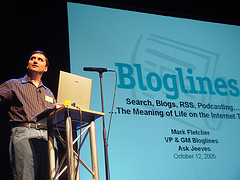 Fletcher (right, in a photo by VicKuP) feared Google and Yahoo would enter the RSS aggregator space and use their considerable marketing power to take over the market. Around the same time, Ask Jeeves expressed an interest in acquiring Bloglines. Fletcher says, “I decided to sell to them in the hopes that they’d be able to send some of their traffic to Bloglines and drive our user numbers up. We began negotiations in December of 2004 and the deal closed February 4th, 2005.” The deal was reported to be around $10 million.
Fletcher (right, in a photo by VicKuP) feared Google and Yahoo would enter the RSS aggregator space and use their considerable marketing power to take over the market. Around the same time, Ask Jeeves expressed an interest in acquiring Bloglines. Fletcher says, “I decided to sell to them in the hopes that they’d be able to send some of their traffic to Bloglines and drive our user numbers up. We began negotiations in December of 2004 and the deal closed February 4th, 2005.” The deal was reported to be around $10 million.
The purchase
Jim Lanzone, Ask Jeeves’ Senior Vice President of Search Properties at the time, said in a press release, “Bloglines is truly one of the most useful and addictive services on the entire Web. We are excited about providing Bloglines with the resources to grow its service and help it reach a broader audience.”
When asked now about the purchase, Lanzone explains that he loved Bloglines when the deal was made. “Bloglines was the original reader and the best. And I was personally addicted to it,” he says. “It almost immediately became the most useful site on the web to me. So we looked at buying it as an investment. If RSS readers blew up and became the leading gateway to information, we’d be in position A. And remember, it was really early days for blogs and Web 2.0. We would have the best blog search out there.
“We acquired it pretty cheaply – much lower than any reported figures at the time – and we budgeted to more than triple Mark’s resource base. As a former entrepreneur myself, I loved the idea of giving Mark a wide berth and seeing what he could do.”
In the release, Fletcher added, “By joining forces with Ask Jeeves, we will be able to accelerate our growth with access to the millions of unique visitors to Ask Jeeves’ properties. And we are eager to take advantage of Ask Jeeves’ support, extensive resources, operational scale and innovative technologies to expand and improve the services we deliver to users.”
Second time around
Despite the lofty words, Fletcher knew that acquisitions didn’t always go smoothly. In 2000, he sold another startup, eGroups, to Yahoo. “When eGroups was acquired by Yahoo in 2000, we had about 150 employees running the service,” he explains. “Within two years of being acquired and renamed Yahoo Groups, that number was down to 3 people running a service that has a staggering amount of email traffic and a huge user base. The development and evolution of Y! Groups stagnated for a very long time after the acquisition. Of course, Yahoo can do whatever they want with the service; they bought it. That was an object lesson in what can happen to a startup after an acquisition.”
So he knew a negative outcome was a possibility with the Bloglines deal. He says, “I went into the Bloglines acquisition with my eyes open. Once you sell your company, it really isn’t yours anymore. This may seem obvious, but until you go through it, you don’t know the emotions you’ll go through as other people start making decisions about how to run ‘your baby’.
Continued…Kristin is the latest addition to our stellar customer support team. She joins Michael, Merissa, Ann, and Jason R. in making our customers happy everyday. Kristin works out of our Chicago office. Welcome Kristin, it’s great to have you on the team.
SXSW Interactive is a 5-day event with 1,041 sessions presented by 1,648 speakers.
 RaceSplitter, a race timing iPhone app, is Makalu Interactive’s first step in transitioning from a services company to a products company. In an email, Makalu’s Matt Henderson (right) wrote, “In the course of designing and developing this product, we crossed just about every lesson in REWORK...The overall experience of designing and developing our own application, having full control of the product and its/our destiny was a game-changer for us, and there’s no going back.” Below, Henderson tells us more about the process.
RaceSplitter, a race timing iPhone app, is Makalu Interactive’s first step in transitioning from a services company to a products company. In an email, Makalu’s Matt Henderson (right) wrote, “In the course of designing and developing this product, we crossed just about every lesson in REWORK...The overall experience of designing and developing our own application, having full control of the product and its/our destiny was a game-changer for us, and there’s no going back.” Below, Henderson tells us more about the process.
Since 2001, our small team at Makalu Interactive has provided web design and development services for clients around the world. We’ve been fortunate to work on some high-profile projects, including the original CatalogChoice.org site, which gained over one million users in its first year, and the interactive game anchoring the Google & Virgin America cross-marketing campaign, Day in the Cloud. (And as a side note, Sortfolio has proven to be an amazing source of high-quality leads for us.)
Despite success in client work, we’ve always imagined that creating our own products would bring deeper satisfaction, and provide the opportunity to succeed beyond the linear function of available manpower. As a team of people passionate about great user experience — and having studied the companies that make them (like Apple) and the processes through which they are made — we’ve always been curious as to just what kind of product we would be capable of making.
We’ve always identified with 37signals. It was inspiring to watch a team of people that seemed so much like ourselves transition from a web design company (like ourselves) to a highly successful products company. We also enjoyed both Getting Real and REWORK, as they articulated a refreshing view and simple approach to many of the issues we struggled with. (It was no small satisfaction to later learn that a former employee of Makalu, Mike Rohde, would end up being the designer of the REWORK illustrations.)
Not only did we try to apply the ideas from Getting Real & REWORK to our client services business, we later found them particularly valuable when making our first steps in the direction of becoming products company.
Last year, we were approached by a group of people associated with NENSA.net, FasterSkier.com and FlyingPointRoad.com, interested in having a timing app developed, for recording split times and providing relative racer position during nordic ski events. With European timing devices costing $500 and up, and the previously popular Palm app going the way of the PalmOS, it seemed natural that something should be built for the iPhone.
In certain nordic ski races, similar to cycling time trials, racers start individually or in waves, separated by a start time interval — say, 30 seconds. If you’re a coach on the course, timing racers as they pass by, it’s difficult to know who’s in the lead. Although it does other things, that’s the essential problem that app solves.
We accepted the project, and got to work. The app would be called RaceSplitter.
It soon became apparent that the app had the potential to be an ideal first product for Makalu. It passed both the “scratch your own itch” and “focus on what doesn’t change” tests. As both participants and observers in similar sports, we were deeply familiar with the application domain, and needed such an app ourselves. And unlike an app for, say, telling the world you’ve checked in at Starbucks, a sports timing device is something that should be as relevant in five years as it is today.
We put together a proposal, in which Makalu would acquire ownership of the app, with the client keeping a minority stake. Seeing our interest, not only in the app itself, but also in building a business around the product, they accepted our offer and RaceSplitter became Makalu’s first product.
As a client provider, one always hopes to give 100% to the client, but we’d be lying if we didn’t admit that becoming the app’s owner didn’t provoke a psychological change. This was the chance we’d been waiting for; to discover what we were truly capable of.
We poured our hearts and abilities into the product. As believers that user experience extends to every way in which a product interfaces its users, we worked as hard on things like the pre-launch sign-up site, announcement emails, even the app icon, as we did on the app itself.


As emphasized in REWORK, even though our 1.0 would be minimal in terms of features, it wouldn’t be half-assed; it’d be “at-home good”.
Continued…Trying to whittle down an inbox of 130 to 0 is intimidating. You can knock off 20 and it doesn’t feel like you made any progress. It would be useful if an email app had a “help you to get to inbox zero” mode where it would only show you 20 emails at a time. Once you knocked those out, 20 more fill in. This way you can see the progress you are making on a small scale (from 20 to 18 to 13 to 7 to 0) and stay motivated to keep knocking them out on a large scale.
I wish I had another example besides Apple but I don’t…